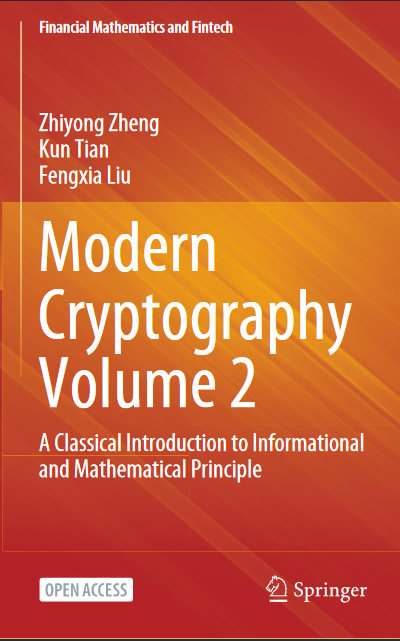موضوعات
آموزش و پرورش
ادبیات و زبان
پزشکی، دندانپزشکی و داروسازی
تاریخ و جغرافیا
داستان و رمان
دیگر
دین و فلسفه
روانشناسی
ریاضیات و آمار
سلامتی، تناسب اندام و رژیم غذایی
شیمی و پلیمر
علوم اجتماعی و حقوق
علوم زیستی و بیوتکنولوژی
فیزیک و نجوم
کامپیوتر و اینترنت
کتابهای کودکان و داستان
کسب و کار و اقتصاد
کشاورزی و دامپزشکی و غذا
معماری
مهندسی و فناوری
هنر و تئاتر
محصولات
Modern Cryptography Volume 2 A Classical Introduction to Informational and Mathematical Principle - Original PDF
نویسندگان: خلاصه: Preface For integer factorization and discrete logarithm calculation, P.W.Shor published an effective quantum calculation in SIAM Journal on Computing in 1997, which is called the Shor algorithm in academic circles. Classical public key cryptosystems such as RSA, ECC and so on could not resist the attack of the Shor algorithm, so the major security risks of public key cryptosystems are completely exposed to the Shor algorithm and quantum computer. In the past 20 years, the rise and development of post-quantum cryptography have close relation with the lattice cryptosystems. The academic community believes that the hard problems on lattice, such as the shortest vector problem (SVP), the continuous shortest vector problem (SIVP) and the determination of the shortest vector problem (GapSVP) can resist quantum computing effectively, so the public key cryptosystems based on the hard problems on lattice become the core theory and technology of the post-quantum cryptography. At present, there are six kinds of published post-quantum cryptosystems: 1. Ajtai-Dwork cryptosystem (1997). Ajtai constructed a collision-resistant Hash function by the circulant matrix and ideal matrix, and converted the collision point into the shortest vector problem on q-ary integer lattice. Ajtai first proposed the concept of random lattice (Gauss lattice) in 1996, and established the famous reduction principle ‘from the worst case to the average case’. The security of Ajtai-Dwork cryptosystem could be fully proved by this reduction principle. 2. GGH/HNF cryptosystem (1997). In 1997, Goldereich, Goldwasser and Halevi constructed a public key cryptosystem based on the closest vector problem on the q-ary integer lattice, which was further improved by Micciancio using the Hermite normal basis in 2005. The idea of Micciancio is very simple. Since the HNF basis of any lattice can be easily computed from its generated matrix, the GGH cryptosystem uses the HNF basis as the public key directly. 3. NTRU cryptosystem (1998). Number Theory Research Unit (NTRU) is a quantum-resistant computing public key cryptosystem developed by J. Hoffstein, J. Pipher and J. H. Silverman in Brown University in 1998, which has become the most attractive post-quantum cryptosystem due to its simple algorithm, fasآیا کتاب مورد نظر هنوز بر روی سایت قرار نگرفته است؟ جای نگرانی نیست! کافی است بر روی گزینه سفارش کتاب کلیک کرده و درخواست خود را ثبت کنید. در کمتر از چند ساعت کتاب شما را آماده خواهیم کرد.
